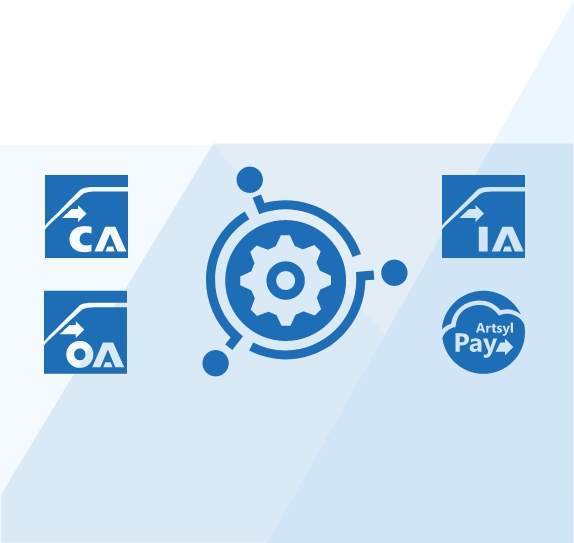Efficiency and productivity are paramount in any industry and every niche today. Microsoft 365, a comprehensive suite of productivity tools, has revolutionized the way we work by integrating powerful applications such as Word, Excel, Outlook, and Teams.
However, the true potential of Microsoft 365 is unlocked through the use of automation tools that streamline repetitive tasks, enhance collaboration, and boost overall productivity. In this article, we will delve into the world of automation within Microsoft 365:

Automate your entire invoicing workflow by integrating InvoiceAction with Microsoft 365.
Capture, process, and approve invoices seamlessly while reducing manual errors and speeding up payment cycles.
Microsoft 365 offers a variety of built-in and third-party automation tools to streamline your workflow and boost productivity. Here’s a breakdown of the key types.
Microsoft Power Automate
The native automation engine within Microsoft 365. Power Automate allows you to create automated workflows (called flows) that connect various apps and services within the Microsoft ecosystem and beyond.
You can automatically send an email notification when a new form is submitted in SharePoint, copy data from one spreadsheet to another based on specific criteria, or trigger a meeting invite when a new deal is created in Dynamics 365. We will discuss these workflows in the next section.
Microsoft Flow (Legacy)
The earlier version of Power Automate is still functional for existing flows but is no longer under active development. Microsoft recommends migrating existing flows to Power Automate for continued support and access to new features.
DISCOVER MORE: Microsoft Dynamics 365 Data Capture & Process Automation
Microsoft Teams Automation
A simplified automation tool embedded directly within Microsoft Teams. It allows you to create basic workflows to automate repetitive tasks within Teams, like sending notifications, approving requests, or managing tasks.
For example, you can automatically assign a task to a specific team member when a new channel is created, post a message to a channel when a new file is uploaded, or trigger a virtual happy hour reminder every Friday afternoon.
Third-Party Integration Tools: Multiplying the Power of Automation in Microsoft 365
Numerous third-party tools integrate with Microsoft 365, offering a wider range of automation capabilities. These tools connect Microsoft 365 with various external applications and services, allowing for more complex workflows.
Examples include Artsyl docAlpha, Zapier, Automate.io, and Tray.io — all these popular options enable connections between Microsoft 365 and project management tools, CRMs, marketing automation platforms, and more.
Remember, a successful automation strategy involves identifying repetitive tasks and using automation tools to free up your time for more strategic work.
Simplify purchase order management by using OrderAction in combination with Microsoft Teams. Automatically capture and organize purchase order data, streamline approvals, and ensure timely order fulfillment.
Book a demo now
As we know, Microsoft Power Automate is a powerful tool designed to create automated workflows between your favorite apps and services. Here are a few examples of simple workflows you can set up:
Automated Email Alerts: Set up workflows to receive notifications for important emails or changes in shared documents. This ensures you never miss critical updates.
Data Collection and Reporting: Automatically collect data from various sources and compile it into reports. For instance, gather responses from a Microsoft Forms survey and export them to an Excel spreadsheet.
Task Management: Create tasks in Microsoft To-Do or Planner based on emails or calendar events. This helps in organizing tasks and deadlines seamlessly.
READ MORE: What Is Microsoft SharePoint? Introduction to Sharepoint
Microsoft Teams Automation takes collaboration a step further by integrating automation directly into your communication platform:
Automatic Channel Creation: Set up workflows to create new Teams channels for projects or departments automatically. This ensures that every team has a dedicated space for collaboration.
Meeting Scheduling: Automate the scheduling of recurring meetings and send reminders to participants. This reduces the administrative burden of managing meeting schedules.
Document Management: Automatically save and organize files shared in Teams channels to OneDrive or SharePoint. This helps in maintaining an organized document repository without manual effort.
By harnessing the power of tools like Microsoft Power Automate and Microsoft Teams Automation, you can automate mundane tasks, ensure consistency, and improve collaboration across your team. Whether you are looking to automate email responses, manage project workflows, or simplify data entry, Microsoft 365’s automation capabilities provide a robust solution.
Revolutionize your document handling by integrating docAlpha with Power Automate. Automate data extraction, routing, and archiving to save time and reduce operational costs. Elevate your productivity instantly!
Book a demo now
Automating AP and AR in Microsoft 365
Now that we know about automation tools for Microsoft 3565, let’s explore how Microsoft 365’s powerful automation capabilities can revolutionize the way you handle AP and AR tasks, making your financial operations smoother and more efficient.
Microsoft Power Automate for AP and AR Automation
Microsoft Power Automate is a robust tool that enables the automation of workflows across various applications and services. Here are some practical examples of how it can be used to automate AP and AR processes:
Invoice Processing: Automatically capture, route, and approve invoices using predefined workflows. Power Automate can extract invoice data from emails or scanned documents, send it for approval, and update financial records in real time.
Payment Reminders: Set up automated reminders for due payments. This can include sending notifications to vendors about upcoming payment dates or reminding customers about overdue invoices, ensuring timely payments, and reducing late fees.
Expense Reporting: Streamline the process of submitting, reviewing, and approving expense reports. Employees can submit reports through a standardized form, which are then automatically routed to the appropriate managers for approval.
FIND OUT MORE: Why Microsoft Dynamics 365 is the Ultimate Solution
Microsoft Teams for Collaboration and Automation
Microsoft Teams enhances collaboration while integrating automation to facilitate seamless AP and AR management:
Automated Notifications: Create Teams channels dedicated to AP and AR tasks, where automated notifications about invoice statuses, payment approvals, or overdue accounts are posted. This keeps all relevant stakeholders informed in real time.
Document Sharing and Management: Automate the organization and sharing of AP and AR documents within Teams. For example, invoices can be automatically uploaded to a designated folder in SharePoint, accessible to the finance team for review and processing.
Chatbots for Quick Queries: Implement chatbots within Teams to handle routine queries about invoice statuses, payment dates, or expense report submissions. This reduces the burden on the finance team and provides instant information to employees.
Integration with Excel and Dynamics 365
You can use Excel’s advanced data analysis features in conjunction with Power Automate to generate real-time reports on AP and AR metrics. This helps in monitoring cash flow, identifying trends, and making informed financial decisions.
Seamless Integration with Dynamics 365
Microsoft Dynamics 365, integrated with Power Automate, allows for end-to-end automation of financial processes. This includes everything from invoice generation and payment processing to detailed financial reporting and analytics.
Automating AP and AR processes within Microsoft 365 brings numerous benefits, from increased efficiency and accuracy to improved cash flow management and financial oversight. By leveraging tools like Microsoft Power Automate, and Microsoft Teams, and the seamless integration with Excel and Dynamics 365, businesses can transform their financial operations.
Integrate InvoiceAction with Microsoft 365 to achieve precise and timely financial reporting. Automate the capture and entry of invoice data, reduce discrepancies, and maintain accurate financial records. Improve your
financial management!
Book a demo now
What is the Flow in Microsoft Power Automate?
This is a blueprint for an automated process within Microsoft 365. Flows connect various apps and services, triggering actions based on predefined conditions. These workflows can automate tasks like sending notifications, copying data, or creating reports.
What Are Trigger and Action in Microsoft 365?
The initiating event within a flow sets the automation process in motion. Triggers can be actions within Microsoft 365 (e.g., receiving an email, or creating a new file) or external events from connected applications (e.g., a new lead generated in a CRM). After a trigger is activated, an action is performed. Actions can be sending emails, updating data in spreadsheets, creating new tasks, or interacting with external applications.
READ NEXT: Making Transaction Data Available in Microsoft Dynamics 365
What is a Connector in Microsoft 365?
This is the bridge that allows flows to connect with different apps and services within or outside the Microsoft 365 ecosystem. Connectors provide standardized access to data and functionalities offered by these applications, enabling seamless automation across various tools.
How Important Is a Runbook in Microsoft 365 Automation?
This detailed document outlines the steps involved in a complex automation process. Runbooks are particularly helpful for managing intricate flows with multiple triggers, actions, and conditional branches. They provide a clear roadmap for understanding, troubleshooting, and maintaining these automated workflows.
Seamlessly manage and track orders by integrating OrderAction with Microsoft 365. Automate order data capture, ensure compliance and enhance visibility across your supply chain. Streamline your order management processes and enhance operational efficiency now!
Book a demo now
Final Thoughts: Explore the Power of Automation Tools in Microsoft 365
Automation tools for Microsoft 365 are more than just time-savers; they are game-changers that can significantly enhance your productivity and streamline your workflow. By harnessing the power of these tools, you can automate mundane tasks, ensure consistency, and improve collaboration across your team. Whether you are looking to automate email responses, manage project workflows, or simplify data entry, Microsoft 365’s automation capabilities provide a robust solution. Embrace these tools to elevate your work processes, reduce errors, and achieve more with less effort. Start exploring the possibilities today, and watch as your productivity soars to new heights.



 10 Benefits of Process Automation
10 Benefits of Process Automation Utilizing Microsoft ERP and OCR for Document Processing: Optimizing Efficiency and Accuracy
Utilizing Microsoft ERP and OCR for Document Processing: Optimizing Efficiency and Accuracy Streamline PO Processing with Purchase Order Automation
Streamline PO Processing with Purchase Order Automation Why Microsoft Dynamics 365 is the Ultimate Solution
Why Microsoft Dynamics 365 is the Ultimate Solution Invoice Automation: How to Automate Invoice Processing
Invoice Automation: How to Automate Invoice Processing MS Dynamics: A Comprehensive Guide
MS Dynamics: A Comprehensive Guide